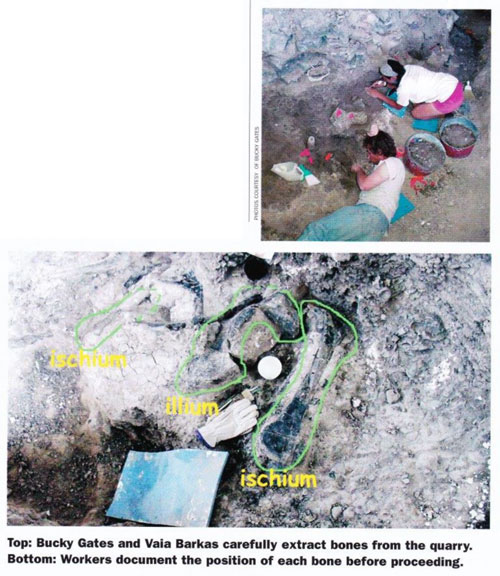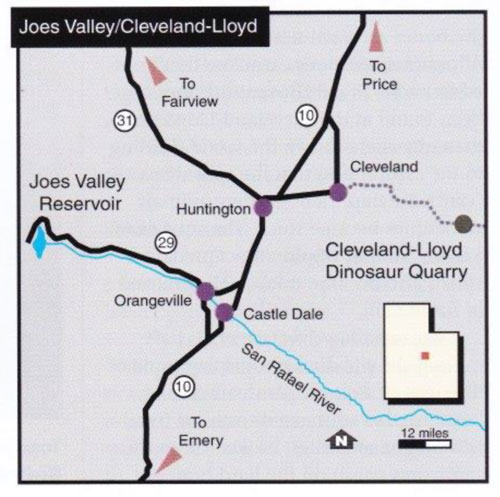 By Dave Webb
By Dave Webb
Utah Outdoors - June 2002
THOUSANDS OF DINOSAUR BONES have been pulled from Cleveland-Lloyd Dinosaur Quarry, a small area of mudstone in the middle of nowhere, on the northwest edge of Utah’s San Rafael Swell. The quarry is one of the oldest and most prolific in the world and the bones it yields have helped establish the science of paleontology Fossils from the site are displayed in over 60 museums around the world.
Now, researchers from the University of Utah - with help from volunteer fossil hunters - are reworking the quarry, finding evidence that contradicts some long-held beliefs, clues that may lead to important new theories, All this while tourists gaze over their shoulders and ask them questions, A mysterious death trap.
The Emery County quarry, about 30 miles south of Price, has been worked on and off since the late 1920s and bones from at least 70 dinosaurs have been found there. Roughly 90 percent of the bones are from flesh eaters, mostly Allosaurus, a vicious carnivore that hunted in packs. More Allosaurus bones have been found at the Cleveland-Lloyd site than anywhere else in the world, leading to the assumption that the spot was a "carnivore trap," a hog where animals sometimes became stuck. The squeals of a dying animal would attract predators, which also became stuck as they moved in for the kill.
Recently, however, scientists have noticed the site does not display some of the signs of a classic carnivore trap. A large number of sheared teeth are usually found at such sites, broken off as the carnivores gnash on the hard bones of their prey. And bones found in the traps are often broken, the result of the huge animals tromping on bodies as they close in for the kill, and as they thrash around trying to pull free. But sheared teeth and broken bones are rarely found at Cleveland-Lloyd.
Why did so many dinosaurs die in this small area? What killed them? Why are their bones so well preserved? The mudstone that contains the fossils is pan of the Morrison formation, deposited during the Jurassic period some 150 million years ago Bucky Gates, a University of Utah graduate student, is attempting to piece together clues to solve this Jurrasic murder mystery lie is researching the site for his master’s thesis, under the direction of Scott Sampson, curator of vertebrate paleontology for the Utah Museum of Natural History and assistant professor of geology and geophysics at the university.
Past research focused on the geology of the area. But Gates is focusing on taphonomy - the processes that affected the bones as they became fossilized. He is focusing on two small areas that have not been worked before, identifying tiny fossils from plants and animals in addition to the large dinosaur bones that made the site famous. He is making a three-dimensional map of the site and plotting the location of every fossil, so each piece of evidence can be studied in its context.
What is be finding? Most of the bones are in pristine condition, suggesting that they were covered in some way soon after death. A few show wear similar to that found on bones at Dinosaur National Monument in Vernal, which were washed downstream by moving water before being caught in a sandbar. Fossilized algae are found in the mudstone, but there is no evidence of fish. Gates says this suggests the area was covered periodically by water, but was not part of an established lake or river.
These clues and others lead Gates to believe the area was arid, with meandering rivers, and that several factors came together to cause the death of the dinosaurs and preservation of the bones. He speculates the site may have been a watering hole and the animals died during a drought. The carnivores would be the last to die, and they would stay at the site and die of starvation before they would leave and die of thirst. But some catastrophic event was still needed to cover the bodies while they were in good condition — perhaps a volcanic eruption.
The study is still in its early stages. Fieldwork must be completed and the data must be analyzed before theories can be supported. Gates hopes to complete research this summer, with conclusions ready for peer review next fall.
Sampson, who has been involved in significant research projects around the world, says this study may well re-write the book on the Cleveland-Lloyd Quarry.
Paleontologist for a day
Volunteers are playing an important role at the dig Some are students taking a break between semesters, others are retired folks or adults who can take a few weeks off work. They are regular people from around the country, living the common dream of getting their hands dirty digging for dinosaur bones. After receiving brief training from the Museum of Natural History, they go to work with trowels, brushes and tiny picks, carefully uncovering documenting and preserving fossils.
The museum provides volunteer workers to help with paleontologic and archaeological studies every year. it also conducts natural history field trips for student and adult groups, In addition, volunteers are often needed to help with workshops for children at the museum. Contact the museum for more info, (801) 5815578, www.umnh.utah.edu.
If you go
 The ClevelanerloydDinosaur Quarry was designated a national landmark in 1966 it is managed by the BLM and is set up to accommodate tourists, even while research is underway. Crews work the site on a periodic basis - there may be work under way when you visit. If not, you will still be able to view partially exposed bones that are still in the ground. Two sheds protect the actual bone beds, and provide shade for workers and tourists. But there are certainly fossils away from the sheds in areas that have yet to be studied. (Collecting rocks or fossils is prohibited.)
The ClevelanerloydDinosaur Quarry was designated a national landmark in 1966 it is managed by the BLM and is set up to accommodate tourists, even while research is underway. Crews work the site on a periodic basis - there may be work under way when you visit. If not, you will still be able to view partially exposed bones that are still in the ground. Two sheds protect the actual bone beds, and provide shade for workers and tourists. But there are certainly fossils away from the sheds in areas that have yet to be studied. (Collecting rocks or fossils is prohibited.)
A visitor's center houses a mural and displays showing what life - and death - may have been like during the Jurassic period. The center also displays real bones and a life like replica of a teenage Allosaurus, along with replica skulls from several species.
The quarry is open from 10 a m. to 5 pm daily from Memorial Day through Labor Day. It may be open on weekends during the spring and fall, depending on budget constraints. There is an entrance fee of $3 for adults and $2 for children. Under 6 and over 100 (out of respect for fossils) are admitted free.
The quarry is located 13 miles east of the town of Cleveland. (Take U-10 south from Price and follow the signs.) Access is via a maintained gravel road that can be driven by passenger car. Picnic tables, water and restrooms are available. The nearest campground is 20 miles away, at Huntington State Park.
Temperatures can be very hot in the summer and it is advisable to carry water in your vehicle and while hiking the quarry's nature trail.
For more information on the quarry, call the Price BLM office, (435) 636-3600, or visit its web site, https://www.blm.gov/learn/interpretive-centers/cleveland-lloyd-dinosaur-quarry.
”Dinosaurs of Utah and Dino Destinations," a book by Pat Bagley and Gayen Wharton, provides an excellent overview of dinosaurs and dinosaur sites. It was published by White Horse Books and is available at the Museum of Natural History and most Salt lake area bookstores.
